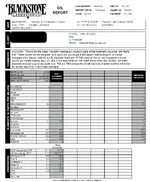- :
- Canada
I realize that there is already a "Skyactiv Oil Analysis" thread, but it's posted in the CX-5 sub (which is odd to me, because all of Mazda's current models have Skyactiv engines). Mods, if you think that this post should be merged into that thread, be my guest.
I recently got the results of my first UOA last week. Below are the results. I also posted these results on BITOG, and some of the members are recommending a switch to an SN+ oil. I actually switched to Castrol Edge 5w30 (which has the SN+ certification) when I took the sample. I plan to have another UOA done around the same time next year, after 2 or 3 more oil changes with Castrol Edge.
Car: 2018 Mazda CX-9 Signature, 29127 km (18099 mi) at time of sample.
Oil and filter: Pennzoil Ultra Platinum 5w30 with Mazda PY8W-14-302 filter, 7400 km (4598 mi) OCI.
Pennzoil Ultra Platinum carries the following certifications:
API SN-RC and all previous categories
ILSAC GF-5
ACEA A1/B1-10, A5/B5-10, A1/B1-12, A5/B5-12
Dexos 1 (unsure if it is gen 2 certified)
Oil was in service from May to Oct (six months). Temps ranged from 30c to 10c. New OEM oil filter and AEM dry flow engine air filter were used. I drive it fairly aggressively on a daily basis, but rarely go WOT (maybe once or twice a month, just to stretch its legs). Mileage on the vehicle was 29127 km (18099 mi) at the time the sample was taken. I regularly change the oil every 7000-7500 kms, and I use a new OEM Mazda oil filter (PY8W-14-302) every time. It's fueled with Shell 91 only. During the last fuel fill before the oil change, I added a bottle of STP fuel injector cleaner and ran the tank to almost empty, then changed the oil (and took this sample).
The car has a CorkSport air intake modification and a throttle response controller. Nothing out of the ordinary to report as far as ownership. The CX-9 has over 30000 km right now and appears to be running perfectly fine so far.
Previous oil change (not reported) was Pennzoil Ultra Platinum 5w30 with 6750 km (4194 mi), new OEM Mazda oil filter with AEM dry flow engine air filter in use.
UOA was performed by Bureau Veritas in Edmonton, AB.
PDF copy of report attached. According to the report, everything is normal. The rep I talked to mentioned that they do an oil/fuel dilution test, but I don't see the results of that on the report, so I sent him an email a couple of days ago to find out why the results were not included. I'll post when I have an update.
I recently got the results of my first UOA last week. Below are the results. I also posted these results on BITOG, and some of the members are recommending a switch to an SN+ oil. I actually switched to Castrol Edge 5w30 (which has the SN+ certification) when I took the sample. I plan to have another UOA done around the same time next year, after 2 or 3 more oil changes with Castrol Edge.
Car: 2018 Mazda CX-9 Signature, 29127 km (18099 mi) at time of sample.
Oil and filter: Pennzoil Ultra Platinum 5w30 with Mazda PY8W-14-302 filter, 7400 km (4598 mi) OCI.
Pennzoil Ultra Platinum carries the following certifications:
API SN-RC and all previous categories
ILSAC GF-5
ACEA A1/B1-10, A5/B5-10, A1/B1-12, A5/B5-12
Dexos 1 (unsure if it is gen 2 certified)
Oil was in service from May to Oct (six months). Temps ranged from 30c to 10c. New OEM oil filter and AEM dry flow engine air filter were used. I drive it fairly aggressively on a daily basis, but rarely go WOT (maybe once or twice a month, just to stretch its legs). Mileage on the vehicle was 29127 km (18099 mi) at the time the sample was taken. I regularly change the oil every 7000-7500 kms, and I use a new OEM Mazda oil filter (PY8W-14-302) every time. It's fueled with Shell 91 only. During the last fuel fill before the oil change, I added a bottle of STP fuel injector cleaner and ran the tank to almost empty, then changed the oil (and took this sample).
The car has a CorkSport air intake modification and a throttle response controller. Nothing out of the ordinary to report as far as ownership. The CX-9 has over 30000 km right now and appears to be running perfectly fine so far.
Previous oil change (not reported) was Pennzoil Ultra Platinum 5w30 with 6750 km (4194 mi), new OEM Mazda oil filter with AEM dry flow engine air filter in use.
UOA was performed by Bureau Veritas in Edmonton, AB.
Code:
OIL PUP 5w30
MILES IN USE 4.6k
MILES 18.1k
SAMPLE TAKEN 10/16/19
ALUMINUM 2
CHROMIUM <1
IRON 15
COPPER 3
LEAD 1
TIN 1
MOLYBDENUM 51
NICKEL <1
MANGANESE N/A
SILVER <0.1
TITANIUM 2
POTASSIUM 2
BORON 64
SILICON 21
SODIUM 1
CALCIUM 2415
MAGNESIUM 13
PHOSPHORUS 663
ZINC 728
BARIUM <1
VANADIUM <1
ANTIMONY 1
INSOLUBLES N/A
WATER <0.10
FLASHPOINT *F N/A
SUS VIS 210*F N/A
cSt @ 212*F 8.4
VISCOSITY INDEX 179PDF copy of report attached. According to the report, everything is normal. The rep I talked to mentioned that they do an oil/fuel dilution test, but I don't see the results of that on the report, so I sent him an email a couple of days ago to find out why the results were not included. I'll post when I have an update.
Attachments
Last edited:

